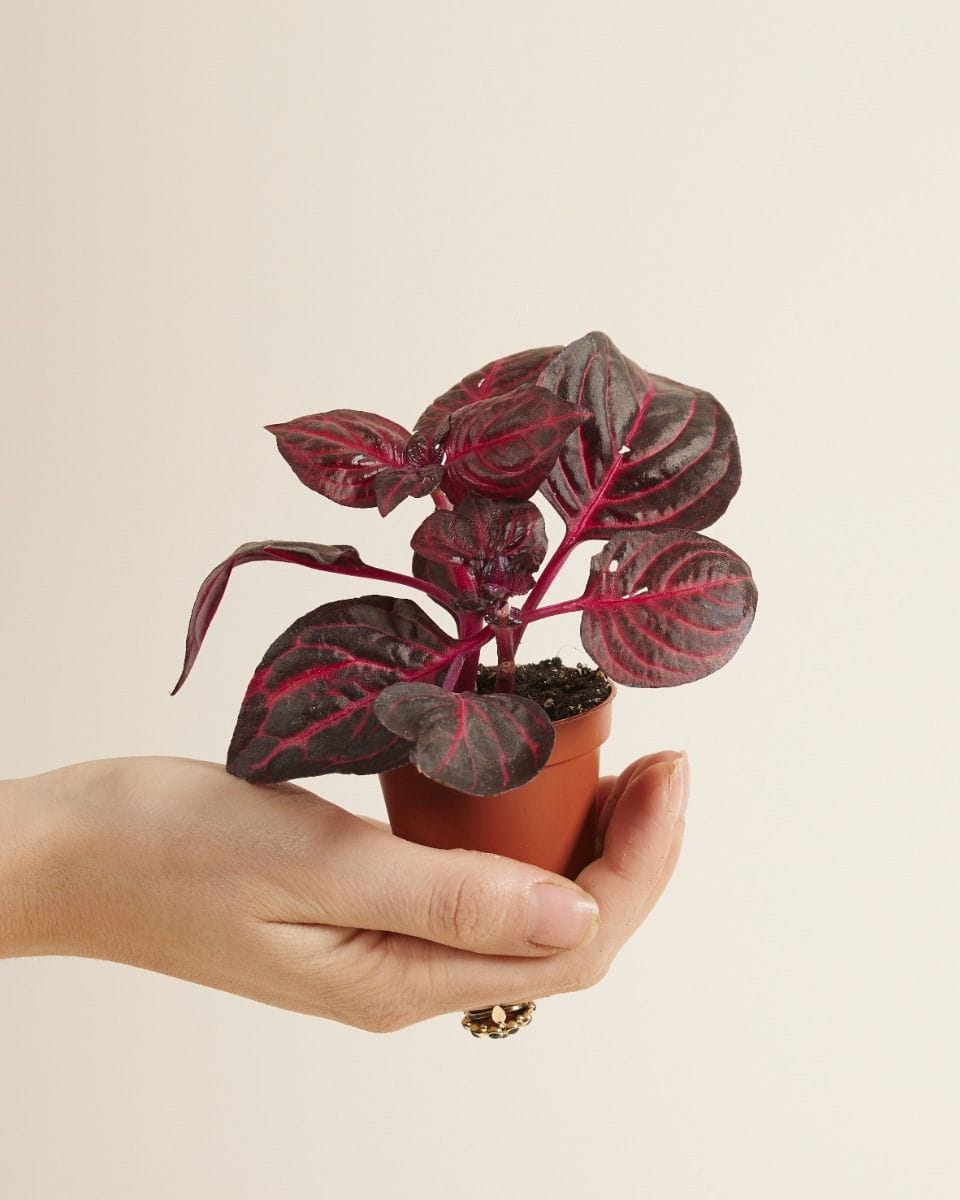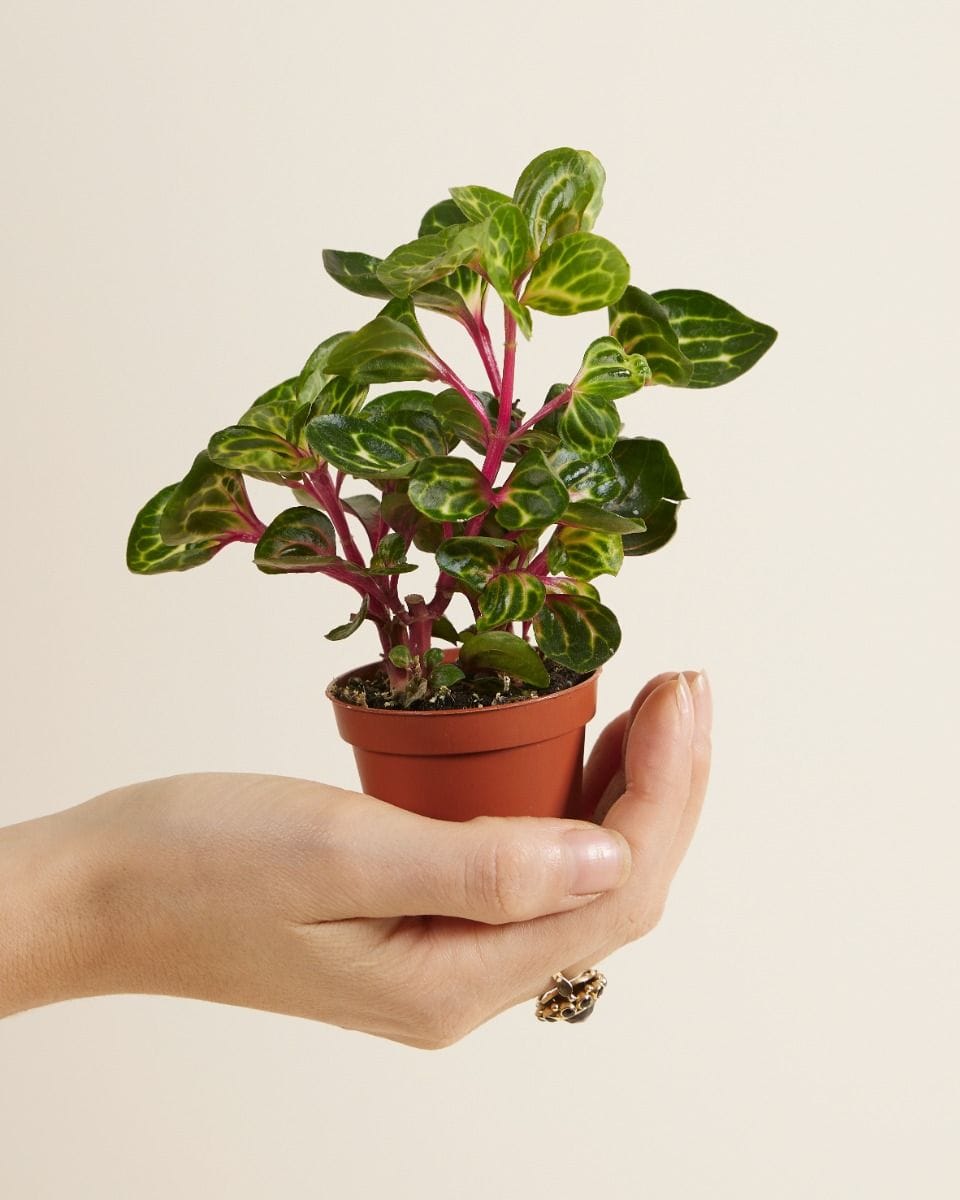In diesem Artikel
- 1 Iresine (Blutblattpflanze) Pflege: Expertentipps für glückliche Pflanzen
- 1.1 Iresine Pflege: 10 Expertentipps für die erfolgreiche Haltung
- 1.2 Iresine Pflege
- 1.2.1 Licht und Standort
- 1.2.2 Gießen
- 1.2.3 Dünger
- 1.2.4 Temperatur & Luftfeuchtigkeit
- 1.2.5 Erde, Substrat und Umtopfen
- 1.3 Iresine Vermehren
- 1.4 Häufige Krankheiten und Schädlinge an Iresine
- 1.5 Sind Iresine Pflanzen giftig?
- 1.6 Kauf deine neue Iresine online bei PLNTS.com
Iresine (Blutblattpflanze) Pflege: Expertentipps für glückliche Pflanzen
Iresine-Pflanzen haben etwas ganz Besonderes: Sie haben winzige Blätter mit wirklich leuchtenden Farben. Es gibt viele Sorten von Iresine, jede mit einer einzigartigen Kombination von Blatt- und Stielfarben. Wegen ihrer schönen Farben werden Iresin-Pflanzen manchmal auch Blutblatt- (Bloodleaf-) oder Steak- (Beefstake-) Pflanzen genannt. Sie sind keine gewöhnlichen Zimmerpflanzen, aber immer mehr Menschen fangen an, sie zu kultivieren, weil sie einfach umwerfend sind!
Iresine ist eine Unterfamilie in der Familie der Amaranthaceae, die hauptsächlich aus Blütenpflanzen besteht. Die Gattung umfasst 20 bis 25 Arten, und diese Schönheiten sind in den amerikanischen Tropen beheimatet. Wenn man ihr genügend Licht gibt und sie nicht übermäßig gießt, ist sie als Zimmerpflanze leicht zu pflegen.

Iresine Pflege: 10 Expertentipps für die erfolgreiche Haltung
- Sorge dafür, dass deine Iresine viel natürliches Licht erhält. Am besten ist ein Platz mit hellem, indirektem Licht, aber vermeide direkte Mittagssonne, da dies die empfindlichen Blätter schädigen kann.
- Die hellen Blätter der Iresine werden weniger farbenfroh und grüner, wenn sie an einem schattigeren Ort gehalten wird. Je heller das Licht ist, desto strahlender sind die Blätter.
- Warte mit dem nächsten Gießen, bis die obere Hälfte der Erde ausgetrocknet ist. Wenn du überprüfen willst, ob die Erde ausgetrocknet ist, steck deinen Finger in die Erde oder verwende einen Feuchtigkeitsanzeiger.
- Gieß nicht zu viel. Das ist ein häufiges Problem bei Iresine, denn ihre Wurzeln können anfangen zu faulen, wenn sie zu viel Wasser bekommen. Vergewissere dich immer, dass die Erde trocken ist, bevor du deine Iresine erneut gießt.
- Stell sicher, dass die Luftfeuchtigkeit hoch ist. Wenn dein Zuhause trocken ist, kannst du einen Luftbefeuchter verwenden oder die Pflanze auf ein mit Wasser gefülltes Tablett mit Kieselsteinen stellen.
- Dünge die Pflanze während der Wachstumsperiode (Frühjahr und Sommer) regelmäßig alle 2-4 Wochen. Zusätzliche Nährstoffe fördern ein gesundes, schönes Wachstum.
- Fördere ein buschigeres Wachstum durch Beschneiden. Iresine-Pflanzen können mit der Zeit etwas langbeinig werden. Regelmäßiges Beschneiden hält sie kompakt und buschig. Du musst nur unterhalb eines Blattknotens schneiden!
- Es ist an der Zeit, deine Iresine umzutopfen, wenn sie aus ihrem jetzigen Topf herausgewachsen ist. Achte darauf, dass der Topf eine Nummer größer ist als der jetzige und dass die Erde frisch und gut durchlässig ist.
- Halte Ausschau nach Schädlingen. Es ist möglich, dass Iresine-Pflanzen Spinnmilben oder Wollläuse anziehen. Achte auf Anzeichen dieser Schädlinge, wie weiße Flecken oder Gespinste auf den Blättern.
- Beobachte die Blattfarbe deiner Iresine. Wenn die leuchtenden Farben zu verblassen beginnen, überprüfe die Licht-, Bewässerungs- und Temperaturbedingungen und pass sie gegebenenfalls an.
Iresine Pflege
Licht und Standort
Wie die meisten farbenfrohen Pflanzen benötigen sie viel Licht. Die Lichtmenge hat immer Einfluss auf die Helligkeit der Blattfarbe. Deine Iresine braucht viel helles Licht, damit ihre Blätter schön knallig bleiben.
Experten-Tipp! Wenn deine lila oder rote Iresine blass wird, ist das ein Zeichen dafür, dass sie zu wenig Licht bekommt. Versuche ein wenig mehr Licht für sie zu finden!
Ein Platz mit viel natürlichem Licht ist am besten, aber vermeide die direkte Mittagssonne, die die Blätter stark angreifen kann. Morgen- oder Abendsonne ist ideal und bringt die Farben noch besser zur Geltung.

Gießen
Iresin-Pflanzen können ziemlich durstig sein, aber das hängt von ihrem Wuchsort ab. Am besten gießt man sie, wenn die obere Hälfte der Erde ausgetrocknet ist. Das lässt sich leicht feststellen, indem man den Finger etwa 2-4 cm tief in die Erde steckt. Wenn sie sich trocken anfühlt, ist es Zeit zu gießen. Die Erde deiner Iresine sollte immer ein wenig feucht bleiben, sie darf nicht völlig austrocknen.
Experten-Tipp! Denk daran, dass du im Winter weniger häufig gießen musst, weil die Tage kürzer sind und die Erde langsamer austrocknet.
Sie reagieren empfindlich auf Überwässerung und können an Wurzelfäule leiden. Die Blätter können gelb oder braun werden und abfallen. Reduziere in diesem Fall die Wassergaben, verbessere die Drainage und setze die Pflanze gegebenenfalls in frische, gut durchlässige Erde um.
Dünger
Ja, wir wissen... Iresine sind so ziemlich alles! Schön, durstig und... hungrig, natürlich! Wenn du deiner Pflanze alle 2 bis 4 Wochen unseren PLNTSdünger gibst, wird sie gut gedeihen. Im Frühjahr und Sommer, während der Wachstumsperiode, kannst du deine Schönheit düngen. Im Winter ist das nicht nötig.
Temperatur & Luftfeuchtigkeit
Deine Iresine-Pflanze fühlt sich bei einer Temperatur von 18-24 °C und einer Luftfeuchtigkeit von 50-60 % am wohlsten. Obwohl sie eine Luftfeuchtigkeit von bis zu 40 % tolerieren kann, fühlen sich diese Pflanzen unter so trockenen Bedingungen nicht wohl. Bei zu trockener Luft kann sich das Wachstum deiner Iresine verlangsamen, und es kann sogar passieren, dass sich die Ränder ihrer Blätter braun färben. Wenn deine Luft also zu trocken ist, solltest du die Luftfeuchtigkeit für deine Zimmerpflanzen erhöhen!
Erde, Substrat und Umtopfen
Im Allgemeinen ist es eine gute Idee, deine Iresine alle 1 bis 2 Jahre in einen größeren Topf zu setzen. Du weißt, dass es an der Zeit ist, wenn die Wurzeln mehr als die Hälfte des Topfes ausfüllen oder aus den Drainagelöchern herausragen. Gehe beim Umtopfen behutsam vor, und versuche, die Wurzeln so wenig wie möglich zu stören.
Wähle beim Umtopfen eine Erde, die sowohl gut drainiert als auch nährstoffreich ist. Wir empfehlen die Verwendung von biologischer Zimmerpflanzenerde von PLNTS, um gute Ergebnisse zu erzielen.
Iresine Vermehren
Die Vermehrung von Iresine ist recht einfach. Die einfachste Art, Iresine zu vermehren, besteht darin, einen mindestens 10 cm langen Stiel mit mindestens 3 Blättern am Stiel abzuschneiden. Schneide diese Stängel mit einer sauberen und scharfen Gartenschere ab. Schneide idealerweise direkt unterhalb eines Knotens (dort, wo die Blätter mit dem Stängel verbunden sind), denn dort treiben am ehesten neue Wurzeln aus.
Du kannst deinen Iresine-Steckling bewurzeln, indem du ihn entweder in sauberes Wasser stellst, bis sich Wurzeln bilden, und ihn dann eintopfen, oder indem du den frischen Steckling direkt in Erde steckst. Halte die Umgebung in beiden Fällen warm und feucht und vermeide direktes Sonnenlicht, bis der Steckling gut angewachsen ist.

Häufige Krankheiten und Schädlinge an Iresine
Iresine-Pflanzen sind empfindlich gegenüber Schädlingen wie Wollläusen, Blattläusen, Schildläusen und sogar Weißen Fliegen. Diese lästigen Insekten konzentrieren sich auf den weichen und jungen Teil deines grünen Babys. Um sie zu sehen, denn sie sind winzig, braucht man scharfe Augen oder eine Lupe. Aber keine Sorge, diese Schädlinge können beseitigt werden.
Auf unserer PLNTSdoctor-Seite kannst du mehr über sie erfahren, um deine Pflanzenschädlinge zu erkennen und zu beseitigen! Wenn du dich für biologische Schädlingsbekämpfung interessierst, kannst du einen Blick auf unseren Blog werfen.
Sind Iresine Pflanzen giftig?
Es wird dich freuen zu hören, dass die Pflanzen der Gattung Iresine für Kinder und Haustiere ungefährlich sind! Aber sei vorsichtig, denn der Pflanzensaft kann trotzdem Hautreizungen wie Juckreiz verursachen. Sollten deine Kinder oder Haustiere dennoch in deine grüne Schönheit beißen, ist das Kauen oder Verschlucken eines Teils der Pflanze nicht gefährlich.
Kauf deine neue Iresine online bei PLNTS.com
Bei PLNTS.com haben wir die unglaublichen Baby Iresine Herbstii. Wenn du etwas Farbe in deinen Zimmerdschungel bringen willst, sind diese Babys genau das Richtige für dich. Bei PLNTS.com erfüllen wir all deine Pflanzenträume.
At PLNTS.com, we have the incredible Baby Iresine Herbstii. If you want to bring some colour into your indoor jungle, these babies are perfect for you. At PLNTS.com, we cover all your plant dreams - Iresine online kaufen bei PLNTS.com!


